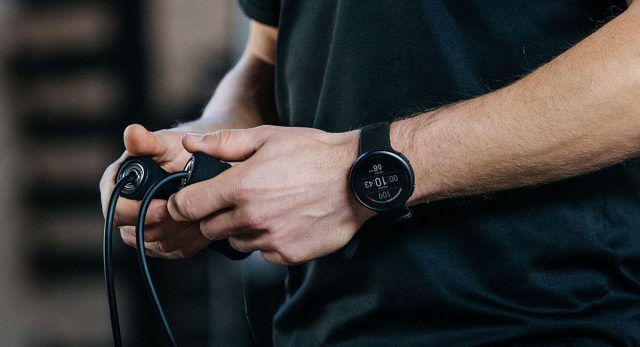Here are some of the most popular methods to calculate your maximum heart rate, arranged from the simplest to the most accurate.
Defining maximum heart rate (HR max) is easy: it’s the highest number of beats per minute your heart can pump under maximum stress.
Determining your maximum heart rate, however, is a little bit harder – but don’t despair.
First, though, a little background.
Why should you calculate your maximum heart rate?
Heart rate-based training enables you to run at the right intensity in order to reach your training goals. In other words, training smart is better than always training hard.
Training intensity is divided into five heart rate zones – from very light to maximum intensity. The heart rate zones are calculated as percentages of your maximum heart rate.
To determine your personal heart rate zones, you first need to know or estimate your maximum heart rate.
For example, within heart rate zone 4, you’ll be training at 81–90% of your HR max and increasing your maximum performance capacity.
Alternatively, at heart rate zone 3 (which is usually your average heart rate running), you’ll be training at the slightly reduced level of 71-80% of your HR but you will still be improving the efficiency of blood circulation.
To determine your personal heart rate zones, you first need to know or estimate your maximum heart rate.
What is my maximum heart rate?
So now you’re ready to start calculating max heart rate, where should you start?
If you’ve ever attempted to calculate resting heart rate, then is obviously the opposite of this. Instead of calming your heart down, you’re going to push it to the limit.
Calculating maximum heart rate requires that you’re ready to sweat and have the right equipment to measure it for you. If you’re simply curious to know what is my max heart rate, then you can always start by using the tools below to estimate it.
Is there anything that will influence your maximum heart rate? Factors such as age, fitness level, stress and medication like beta blockers will affect your heart rate.
Does your sex affect your max heart rate? To calculate max heart rate male or female is exactly the same. However, you may be interested to know that smaller people usually have a higher maximum heart rate, which is why women often have a higher rate than men.
How to ESTIMATE your maximum heart rate
Your maximum heart rate can be estimated with a commonly used formula:
220 – YOUR AGE
While this is a good starting point, research has shown that this formula is not perfectly accurate for all people, especially for people who have been fit for many years or for older people.
You can use the Maximum Heart Rate Calculator below to estimate your HR max using this method.
MAXIMUM HEART RATE CALCULATOR
How to calculate maximum heart rate WITH A laboratory test
If you’re looking for the most accurate way to calculate your max heart rate, you should have your HR max clinically measured. This is something you’ll need to do in a fancy laboratory environment with high-tech equipment.
The two most common ways are the maximal treadmill and bicycle stress tests. These tests are usually supervised by a cardiologist or exercise physiologist.
How to CALCULATE maximum heart rate with a field test
Besides estimations and tests, you can calculate max heart rate by putting on your running shoes, firing up your heart rate monitor, and heading out into the real world.
You won’t need fancy laboratory equipment for the field test but you’ll still get an accurate and personal estimation of your maximum heart rate. The premise is simple: you warm up properly and then do an exercise that brings you close to your maximum effort.
Please note that for a maximum effort field test it’s best to call a friend and have them join you, just to be on the safe side. Also, make sure you have some hard training under your belt from recent weeks.
Max heart rate Field test example
Do this field test with a training partner. Use a heart rate monitor and note the highest heart rate you can reach. This is your maximum heart rate.
- Warm up for 15 minutes on a flat surface. Build up to your usual training pace.
- Choose a hill that will take more than 2 minutes to climb. Run up the hill once (for at least 2 minutes), building to as hard a pace as you estimate you could hold for 20 minutes. (You don’t have to keep running for 20 minutes, you just need to build up to a pace that you could hold for at least 20 minutes.) Return to the base of the hill.
- Run up the hill again with a faster pace. Get your heart going as hard as you can, building up to a pace you estimate you would be able to hold for 3 kilometres. Observe your highest heart rate on the display.Your max HR is approximately 10 beats higher than the now-noted value.
- Run back down the hill, allowing your heart rate to drop 30–40 beats per minute from where it was.
- Run up the hill once again at a pace that you can only hold for 1 minute. Try to run halfway up the hill. Observe your highest heart rate. This brings you close to your maximum heart rate. You can use this value as your max HR to set your heart rate zones.
- Make sure you cool down for a minimum of 10 minutes.
Doing a maximum heart rate field test while unprepared is a surefire way to end up in maximum distress. If you are unsure, consult your physician before undertaking the test.
If you liked this post, don’t forget to share so that others can find it, too.
Or give it a thumbs up!
I like this article
Please note that the information provided in the Polar Blog articles cannot replace individual advice from health professionals. Please consult your physician before starting a new fitness program.






